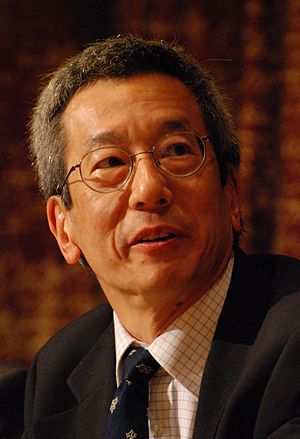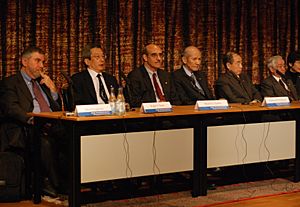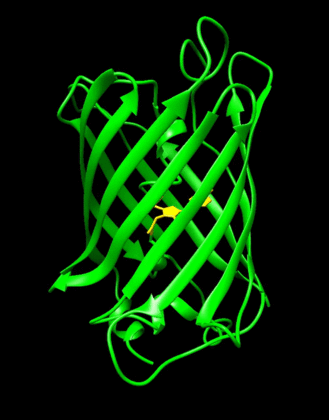Roger Y. Tsien facts for kids
Quick facts for kids
Roger Tsien
|
|||||||||
|---|---|---|---|---|---|---|---|---|---|

Tsien in 2008
|
|||||||||
| Born |
Roger Yonchien Tsien
February 1, 1952 New York City, U.S.
|
||||||||
| Died | August 24, 2016 (aged 64) Eugene, Oregon, U.S.
|
||||||||
| Nationality | American | ||||||||
| Citizenship | United States | ||||||||
| Education | (PhD) | ||||||||
| Known for |
|
||||||||
| Spouse(s) | Wendy Globe | ||||||||
| Awards |
|
||||||||
| Scientific career | |||||||||
| Fields | Biochemistry | ||||||||
| Institutions | |||||||||
| Thesis | The design and use of organic chemical tools in cellular physiology (1976) | ||||||||
| Doctoral advisor | Richard Adrian | ||||||||
| Chinese name | |||||||||
| Traditional Chinese | 錢永健 | ||||||||
| Simplified Chinese | 钱永健 | ||||||||
|
|||||||||
Roger Yonchien Tsien (pronounced "CHEN"; February 1, 1952 – August 24, 2016) was an American biochemist. He was a professor at the University of California, San Diego. He won the Nobel Prize in Chemistry in 2008. He shared this award with Osamu Shimomura and Martin Chalfie. They were honored for their work on the green fluorescent protein (GFP). Tsien also helped create new ways to study calcium inside living cells.
Contents
Early Life and Discoveries

Roger Tsien was born in New York City in 1952. His family was Chinese American. He grew up in Livingston, New Jersey. As a child, Roger had asthma, so he spent a lot of time indoors. He loved doing chemistry experiments in his basement.
When he was just 16, he won first prize in a national science competition. This competition was called the Westinghouse Talent Search. His project looked at how metals connect to a chemical called thiocyanate.
Education and Learning
Tsien went to Harvard University on a special scholarship. He was a very bright student. He finished his bachelor's degree in chemistry and physics in 1972. He graduated with the highest honors. His college roommate, Herman Quirmbach, said Roger was "the smartest person I ever met."
After Harvard, Tsien studied at the University of Cambridge in England. He earned his Ph.D. in physiology in 1977. His research was about creating chemical tools to study how cells work.
Amazing Research and Career
After his Ph.D., Roger Tsien worked as a research fellow. Then, he became a professor at the University of California, Berkeley. In 1989, he moved to the University of California, San Diego. There, he taught pharmacology, chemistry, and biochemistry.
Tsien's work greatly helped the fields of cell biology and neurobiology. He found ways to create glowing tags that could be programmed genetically. These tags let scientists watch molecules move inside living cells in real time. He also made glowing tools to see calcium ions and other important ions in biological processes.
In 2004, Tsien received the Wolf Prize in Medicine. This award was for his important work in designing new glowing molecules. These molecules helped scientists understand how cells send signals.
In 2008, he won the Nobel Prize in Chemistry. He shared it for his work on the green fluorescent protein.
Understanding Fluorescent Proteins
Roger Tsien's lab developed many different colored glowing proteins. Scientists use these proteins to see where and when certain genes are active in cells or whole organisms. Imagine a gene that makes a protein. Scientists can attach the glowing protein gene to it. This makes the protein glow inside the cell when light shines on it. This allows scientists to track its location live under a microscope. This method is so useful that it has changed how we study molecular biology and cell biology.
After the discovery of the original GFP, many new versions were made. Tsien's team made a big improvement in 1995. They changed one tiny part of the GFP. This change made the GFP glow much brighter and last longer. It also made it easier for scientists to use with their existing equipment. Tsien's work helped us understand how GFP glows. He also created new ways to use it and made many new types of GFP.
Here are some key moments in GFP development by Tsien:
- 1994: Tsien showed how the GFP glowing part forms. It needs oxygen but no other proteins.
- 1994–1998: Tsien and his team made many GFP versions. They changed the GFP's genes and structure. New GFP types could glow brighter and in different colors like yellow, cyan, and blue.
- 2000–2002: Tsien created new glowing proteins that shine in shades of red, pink, and orange. This meant scientists could label different parts of living things with "all the colors of the rainbow."
Other important discoveries by Tsien:
- 2002: He found the key difference between GFP and a red glowing protein called DsRed. This difference made DsRed glow red.
- 2002: He developed the first single-molecule DsRed.
- 2004: His team created new "fruit" glowing proteins.
In 2009, Tsien's group developed a new type of Infrared Fluorescent Protein (IFP). These IFPs came from bacteria, not jellyfish. They glow in infrared light. This light can go deeper into tissues.
In 2016, a new super red fluorescent protein (smURFP) was created. It glows very brightly in red. It also doesn't need oxygen to glow, unlike jellyfish proteins.
Calcium Imaging
Tsien was a leader in calcium imaging. He developed many dyes that glow when calcium ions are present. One dye, called fura-2, is widely used. It helps scientists track how calcium levels change inside cells. Other popular calcium indicators, indo-1 and fluo-3, were also developed by his group. He also made glowing indicators for other important ions like magnesium, zinc, and iron.
Cancer Surgery Help
Tsien's group did experiments with mice. They found that glowing peptides could help guide cancer surgery. These peptides are harmless to healthy tissues. They glow when they find cancer cells. This helps surgeons see and remove all the cancer. Clinical trials are still needed for this method.
Industrial Work
Roger Tsien was also a great inventor. He held or co-held about 100 patents. In 1996, he helped start a company called Aurora Biosciences Corporation. He also helped start Senomyx in 1999.
Tsien also supported science education. He helped young scientists learn more about science through special programs.
Personal Life
Roger Tsien came from a family of engineers. His father was a mechanical engineer. His uncles were engineering professors at MIT. His mother was a nurse. The famous rocket scientist Tsien Hsue-shen was a cousin of Roger's father.
Roger Tsien was the younger brother of Richard W. Tsien, who is also a famous neurobiologist. Roger once said, "I'm doomed by heredity to do this kind of work," meaning science was in his family's blood.
He was married to Wendy Globe.
His Passing
Roger Tsien passed away on August 24, 2016. He died while on a bike trail in Eugene, Oregon. Before his death, he had survived cancer and had a stroke in 2013.
His wife, Wendy, said he was "ever the adventurer, the pathfinder, the free and soaring spirit." She added that he would not be forgotten.
Awards and Honors
Roger Y. Tsien received many awards and honors throughout his life. Some of them include:
- National 1st Prize, Westinghouse Science Talent Search (1968)
- Marshall Scholarship, British government (1972)
- Searle Scholar, Searle Scholar program (1983)
- Artois-Baillet Latour Health Prize, Belgium (1995)
- Gairdner Foundation International Award, Canada (1995)
- Elected to the United States Institute of Medicine (1995)
- Elected to the American Academy of Arts and Sciences (1998)
- Elected to the United States National Academy of Sciences (1998)
- Christian B. Anfinsen Award, Protein Society (2002)
- Heineken Prize for Biochemistry and Biophysics (2002)
- Wolf Prize in Medicine, Israel (2004)
- Keio Medical Science Prize, Japan (2004)
- Associate EMBO Member of the European Molecular Biology Organization (2005)
- Lewis S. Rosenstiel Award (2006)
- Elected a Foreign Member of the Royal Society (ForMemRS) (2006)
- Nobel Prize in Chemistry, Sweden (2008)
- E.B. Wilson Medal, American Society for Cell Biology (2008)
- Honorary Fellow of the Royal Society of Chemistry (2008)
- Golden Goose Award (2012)
- Golden Plate Award of the American Academy of Achievement (2012)
See also
 In Spanish: Roger Y. Tsien para niños
In Spanish: Roger Y. Tsien para niños
- Quyen T. Nguyen


